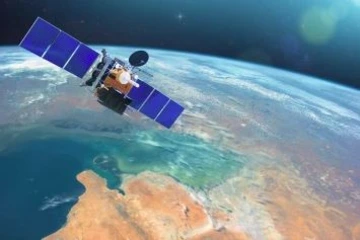By Stephanie Doster, Space 4 Center - November 12, 2024
University of Arizona researchers have created the first astronomical equivalent of a fingerprint database for satellites, a critical first step toward easily identifying human-made objects in the increasingly crowded geostationary orbit.
This database, or spectral atlas, includes 96 satellites in the geostationary orbit, or GEO – home to satellites used for communications, imaging, navigation and other purposes – that are visible from Tucson.
Adam Battle, a Ph.D. candidate in the U of A Lunar and Planetary Laboratory supported by the Space4 Center, led the research, which was published Tuesday in The Planetary Science Journal.

"Satellites look like tiny dots in the sky, even through most telescopes. For decades, humans have launched tens of thousands of objects into space with no mechanism for
identifying them easily," Battle said. "This is the first time this sort of systematic, big atlas of spectral data has been collected for these objects. It gives us a baseline for differentiating space objects, for knowing where everything is and what has changed and keeping that space safe."
The United States Space Surveillance Network, part of the U.S. Space Command, tracks more than 45,000 artificial objects in Earth's orbit, including about 350 active payloads in GEO.
The GEO belt is a unique orbit about 22,000 miles above Earth's equator. Satellites in GEO orbit at the same rate and direction as Earth; from the ground, they appear to stand still. Only so many orbital slots are available in GEO, making them valuable to companies and nations looking to put satellites there. The average lifespan of a satellite in GEO is about 15 to 20 years, after which they are maneuvered into a higher, "graveyard" orbit where they remain as space junk.
"The orbital space around the Earth is getting congested, and we unfortunately do not have license places for satellites to identify them easily. This work is the first step towards making space safe, secure and sustainable," said Vishnu Reddy, director of the university's Space4 Center and a planetary science professor who co-authored the paper. Reddy, Battle's Ph.D. advisor, initiated the project when he started at the U of A nearly a decade ago.
Other co-authors of the research include Roberto Furfaro, professor of systems and industrial engineering and Space4 deputy director, and Space4 Center software engineer Tanner Campbell.
The U of A team used the power of spectroscopy to create the atlas. With spectroscopy, the team can measure how the sun's light interacts with materials on the satellites like metals, paint and solar panels, and how these interactions change with illumination conditions. The results are a detailed pattern of colors for those unique conditions – a color fingerprint – that can be used to identify that specific object.
Using a telescope built by U of A students and housed on campus, Battle observed objects in GEO for 192 nights during every season between January 2020 and June 2022, except for the cloudy summer months. A typical night's worth of observing involved imaging one object every 45 seconds for the entire night. This generated 284 separate datasets and about 190,000 spectra.
As part of his study, Battle focused on repeated observations of five satellite bus types – the central structure to which communications arrays, thrusters and solar panels are mounted – to determine how their spectra varied over nights and seasons and how they differed from the spectra of natural objects.
The resulting atlas contains the unique detailed patterns of colors for 96 individual satellites observed in GEO from Tucson.
"Historically, scientists have used brightness measurements, as the phase angle changes.
But using spectroscopy allows you to add another layer of information, and the ultimate goal is to be able to uniquely identify different satellites with machine learning algorithms trained on these 'fingerprints,'" Battle said. "We can also compare these spectra to samples in the lab to begin estimating what materials are used on the spacecraft."
David Cantillo, another Lunar and Planetary Laboratory graduate student working with Reddy, is building a telescope in Australia, where he plans to expand the atlas by studying space objects in GEO that aren't visible from the United States.
"The next step is to combine the power of machine learning with this incredible dataset for fast and credible identification of satellites," Furfaro said. "We are working towards the goal where we can operationally deploy this tool for a wide range of space applications."
UA News - New 'Spectral Fingerprint' Atlas of Satellites Aims to Improve Space Security

